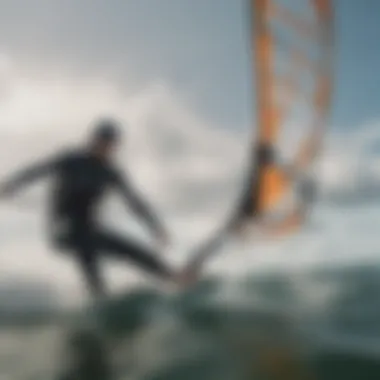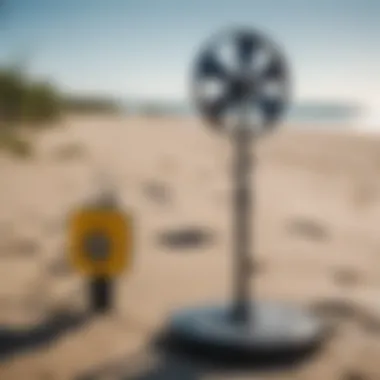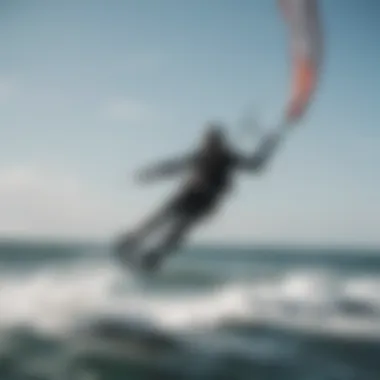Mastering Wind Speed for Kiteboarding Success


Intro
Wind speed plays a critical role in kiteboarding, influencing everything from performance to safety. Knowledge of current wind conditions is akin to the sailor knowing the tides; it’s essential. Understanding the nuances in measuring wind speed can elevate a kiteboarder’s experience, whether you're just starting or have been riding for years.
In this guide, we’ll traverse the terrain of wind, unraveling its complexities. We’ll cover reliable methods for gauging wind velocity, spotlighting tools that enthusiasts swear by. This ensures that every kiteboarder can not only read the wind but also ride it with confidence.
The relationship between wind speed and kiteboarding isn’t merely academic; it impacts maneuverability, control, and overall enjoyment on the water. A gusty day can convert a routine session into an exhilarating adventure or a dangerous endeavor, depending on how well you understand those wind readings. Every twist and turn in this discussion will arm you with the insights needed to become more adept at interpreting wind speed, ultimately making your time on the water safer and more enjoyable.
Prelude to Wind Speed in Kiteboarding
When it comes to kiteboarding, understanding wind speed is as crucial as having the right gear. Wind conditions can make or break your experience on the water. If you're gearing up for a session, knowing how to read the wind can mean the difference between gliding smoothly and struggling to stay aloft. This section delves into the importance of wind conditions and provides a solid foundation to grasp the definition of wind speed.
The Importance of Wind Conditions
For kiteboarders, wind isn't just an accessory; it's the lifeblood of the sport. The wind determines how high you can fly, how fast you can go, and even how stable your ride will be. Underestimating the wind can lead to risky situations—especially for novice riders. A gentle breeze suitable for beginners could quickly turn into turbulent gusts that test an experienced rider's limits.
It’s also important to remember that wind conditions can shift unexpectedly. Sudden changes can occur due to terrain features or weather patterns, turning a calm day into a dangerous one. People refer to this unpredictability in kiteboarding as riding the "wind rollercoaster." For kiteboarders, evaluating wind speed isn’t merely a matter of performance; it directly ties into safety and decision-making.
Hence, knowing how to read the wind and its conditions is an essential skill that every kiteboarder must acquire. Understanding whether the wind is consistent or patchy, strong or light, can prepare you for the varieties of riding experiences available.
Defining Wind Speed
Wind speed is a term that can seem straightforward but entails several nuances in the context of kiteboarding. Essentially, wind speed refers to how fast the air moves relative to the Earth's surface. For kiteboarders, it’s often measured in miles per hour (mph), kilometers per hour (km/h), or knots.
Different conditions call for different interpretations of wind speed.
- Light Wind (0-10 mph): Ideal for beginners learning the basics.
- Moderate Wind (10-20 mph): Good for intermediate riders who want to practice tricks and gain confidence.
- Strong Wind (20+ mph): Primarily for advanced kiteboarders. At these speeds, the ride can become exhilarating, but caution is imperative.
The local environment can heavily influence wind speed. For instance, downwind from tall buildings or mountains, you may experience gusty or variable winds. On the flip side, open water or flat coasts could give you steadier conditions.
Knowing how to define and interpret wind speed allows kiteboarders to make educated decisions about when to hit the waves. In other words, familiarizing yourself with wind speed enables you to respect your capabilities while pushing your boundaries.
How Wind Speed is Measured
Understanding how wind speed is accurately measured is crucial for kiteboarders. This knowledge allows riders to assess conditions before hitting the water, which can prevent accidents and enhance the overall experience. Different measurement tools offer varying levels of precision and user-friendliness, so it's essential to weigh the pros and cons of each option. Adequate measurement is simply not a secondary concern but a fundamental aspect of ensuring a safe and enjoyable ride.
Anemometers: The Standard Tool
When it comes to measuring wind speed, anemometers reign supreme. This device operates by gauging the force of the wind against its blades, and it's widely recognized for providing reliable data. A vast majority of kiteboarders trust anemometers because of their accuracy, making them an essential piece of equipment for both professional and amateur riders.
Key Features of Anemometers
- Precision: Anemometers are designed to offer accurate readings of wind speed, which is invaluable when planning a session.
- Real-time Data: Many models give live wind speed updates, so users can gauge the ever-changing conditions at a glance.
- Versatility: They can be used in various settings, from coastal areas to inland lakes.
However, one must consider that they can be a bit pricey compared to simpler options. Also, keeping it calibrated is necessary for accurate readings, which sometimes gets overlooked in the hustle of prepping for a kiteboarding session.
Other Measurement Techniques
Apart from anemometers, other measurement techniques also play an important role in determining wind speed. Diversifying the tools in your kit can give a more complete picture of conditions—especially when you find yourself in remote locations without access to anemometers.
Wind vanes
Wind vanes are a classic tool used to indicate the wind's direction. While they primarily focus on direction rather than speed, using them alongside other instruments can enhance your understanding of wind conditions.
Key Characteristics of Wind Vanes
- Installation and Maintenance: They are generally easy to set up and often require minimal maintenance.
- Cost-effective: A cost-effective solution for beginners testing the waters before investing in more complex tools.
However, the limitation is apparent; wind vanes can't provide speed measurements, making them best used in conjunction with other methods.


Portable wind meters
For those who prefer a balance between convenience and accuracy, portable wind meters—often held in hand—offer a practical alternative. These compact devices usually employ cup anemometers to measure wind speed directly, and they're celebrated for their affordability and ease of use.
Unique Features of Portable Wind Meters
- Compact Size: Easy to carry in a pocket or bag, making them suitable for on-the-go assessment.
- User-friendly: Generally straightforward to operate, even for those who are new to kiteboarding.
The downside? Their readings, while sufficiently accurate for casual users, might not match the precision of larger, dedicated devices.
Apps and online resources
The digital age has birthed numerous applications and online platforms dedicated to wind speed measurement. These tools often compile data from various sources, delivering comprehensive insights to users in real time.
Key Characteristics of Apps and Online Resources
- Real-time Updates: Keep users informed of wind conditions without the need for physical devices.
- User Community: Many apps include community features where users can share their experiences and insights, fostering a sense of camaraderie among kiteboarders.
However, reliance on technology sometimes means that users face the challenge of unpredictable accuracy. Network coverage can falter in remote areas, leaving users stranded if internet access is required for the reading.
"Having the right tools to measure wind speed can make the difference between a fantastic session and a safety hazard; don’t underestimate their importance."
In summary, understanding wind measurement methods gives kiteboarders the ability to make informed decisions. While anemometers are the gold standard, wind vanes, portable meters, and digital apps collectively contribute to a richer understanding of wind conditions.
Interpreting Wind Speed Data
Understanding wind speed data is critical for kiteboarders who wish to navigate the waters safely and effectively. The way that wind speed is measured and reported can significantly affect one's performance on the water. Different units of measurement can lead to confusion, especially for newcomers to the sport. Knowing how to interpret this data can help kiteboarders make informed decisions about when to hit the beach and when it might be wise to stay on land.
The accurate interpretation of wind speed readings can also influence the choice of equipment and riding styles. Understanding wind strengths can inform the type and size of kite to use, which can greatly enhance safety and enjoyment on the water.
Understanding Wind Speed Units
Miles per hour
Miles per hour (mph) often gets the spotlight in wind speed conversations, especially in regions like the United States. This unit is straightforward and familiar to many. One unique aspect is that it’s easy to relate to personal speed experiences; for example, when driving.
Key Characteristic: A mile is a common distance that many can visualize, making it easier for some to assess conditions.
Benefits: It provides a simple way to understand how fast the wind is blowing relative to other familiar speeds. For a kiteboarder, knowing that 15 mph is a pleasant breeze can help in assessing whether to go kiteboarding or not.
Considerations: However, while it’s user-friendly, miles per hour can be less practical in other regions or for international competition, where metrics like kilometers per hour (kph) or knots dominate.
Kilometers per hour
Kilometers per hour (kph) is frequently used in many parts of the world, especially in Europe and parts of Asia. This metric offers a perspective that might resonate more with some riders, particularly when considering international traveling for kiteboarding.
Key Characteristic: It aligns with the metric system, which is widely adopted globally.
Benefits: For kiteboarders looking at international weather reports, understanding kph is crucial. The conversion from kph to noticeable wind levels can also help one's intuition about safe riding conditions.
Considerations: A drawback is that those using mph might find it slightly perplexing since it’s a scale that they don't use in their day-to-day lives.
Knots
Knots signify nautical miles, making this unit particularly important in the world of water sports. Given that kiteboarding happens on water, understanding knots can be especially relevant.
Key Characteristic: A knot is based on maritime traditions, and it measures wind speed as it relates to navigation and water travel.
Benefits: Many weather stations and marine apps provide wind data in knots. Being conversant in this unit can enhance communication between various boaters, windsurfers, and kiteboarders.


Considerations: However, for those not familiar with nautical terms, knots might feel like a foreign language. Riders would benefit from conversions to more commonly known speed metrics to gauge conditions properly.
Reading Wind Speed Reports
The interpretation of wind speed reports extends beyond just knowing the numbers. An effective reading requires context, such as knowing the local terrain and typical wind patterns. Often, reports will accompany wind speed indicated by weather conditions and forecasts. Being mindful of these surrounding factors can make a world of difference in one’s kiteboarding experience.
"A good kiteboarder doesn’t just check the wind speed. They understand what that speed means for their ride."
Understanding the nuances of a wind speed report can help kiteboarders prepare effectively for the conditions they will encounter. The difference between a windy day and a dangerous storm can be found in paying attention to the details presented in these reports.
Wind Speed Impact on Kiteboarding
Wind speed plays a crucial role in kiteboarding, deeply affecting both performance and safety. Understanding how different wind conditions can modify your riding experience is essential for enthusiasts and professionals alike. Too little wind can leave you sluggish and unable to harness energy from the kite, while excessively strong gusts can pose serious risks. Thus, it’s imperative to recognize and adapt to varying wind speeds. This section provides insight into how wind speed impacts kiteboarding, specifically for different skill levels.
Optimal Wind Conditions for Beginners
For those new to kiteboarding, finding ideal wind conditions is essential for a positive experience. Typically, light to moderate wind speeds ranging from 10 to 15 knots are considered optimal for beginners. This range allows for enough power to keep the kite aloft without overwhelming a novice rider. In these conditions, learners can focus on basic skills such as steering the kite and controlling speed, all while feeling secure.
Here are some tips for beginners navigating wind conditions:
- Choose the Right Location: Flat, open water with minimal obstructions is ideal; look for spots known to have consistent and gentle winds.
- Watch for Wind Patterns: Familiarize yourself with local wind patterns; some beaches may have flukey airflows due to terrain influence.
- Start with a Smaller Kite: Opting for a smaller kite can mitigate the potential for overpowering winds, granting more control.
Being mindful of these factors can smooth the learning curve and enrich the novice experience.
Ideal Wind Speed for Intermediate and Advanced Riders
As riders gain experience, their preferences for wind conditions will evolve. Intermediate and advanced kiteboarders often thrive in wind speeds from 15 to 25 knots. This bracket offers more aggressive performance and trick execution, allowing for jumps, flips, and higher speeds. Riders familiar with their kites often appreciate the adrenaline rush that comes with stronger winds, as the lift and speed can be exhilarating.
Considerations for those skilled riders include:
- Understand Your Kite: Different kite designs react uniquely to various wind speeds; strapped or unstrapped, ensure you are aware of how your gear performs in these conditions.
- Practice Transitioning: Wind gusts can change quickly. Being able to transition with speed and control can enhance performance significantly.
- Utilize Experience: Trust your instincts. Experienced riders can often gauge their limits better, but it's wise to always prioritize safety.
That said, even seasoned riders must remain cautious and sensitive to shifts in weather and wind speed.
When Wind Speeds Become Dangerous
Awareness of when wind speeds become dangerous is perhaps the most critical aspect of kiteboarding safety. Winds exceeding 25 knots can pose serious challenges, even for experienced riders. Gusty winds, in particular, are treacherous; these sudden bursts can easily overpower a kite and catch a rider off guard.
To enhance safety in adverse conditions, keep these guidelines in mind:
- Monitor Weather Reports: Stay connected to reliable weather services or use mobile apps that provide real-time wind updates.
- Know Your Limits: It's vital to assess not just your skill level but also the gear you're using. A too-advanced kite can make dangerous winds even riskier.
- Create an Exit Plan: Before heading out, have a strategy for what to do if conditions deteriorate or winds shift unexpectedly.
"Always prioritize safety over performance. The ocean will always be there, but your well-being is priceless."
Adapting to wind conditions ensures a safer and more enjoyable kiteboarding experience, regardless of skill level. Understanding these elements is a strong step forward in mastering the winds and wires that define kiteboarding.
Tools and Resources to Check Wind Speed
Understanding wind conditions is paramount for kiteboarders, hence why having the right tools and resources to check wind speed can make a world of difference. With the right information, a kiteboarder not only boosts their performance but also enhances their safety on the water. The importance of accurately assessing current wind speed can’t be emphasized enough; it’s like having a compass – essential for navigating the unpredictable waters. This section will delve into the various tools and resources available to kiteboarders to measure wind speed effectively.
Online Weather Services
Online weather services provide a treasure trove of information regarding wind speeds and conditions. These platforms aggregate data from various meteorological sources to offer real-time updates. Not only can these services give kiteboarders a bird's eye view of conditions, but they also often include forecasts. Websites like Windy or NOAA offer detailed wind maps, displaying wind patterns and speeds on an interactive interface.
Using these services has several benefits:
- Accuracy: The data is sourced from professional weather stations, ensuring reliable information.
- Flexibility: Kiteboarders can access data from anywhere, making it easy to check conditions before heading out.
- Advanced Features: Many online platforms provide forecasts and alerts for changing wind conditions, which is especially useful for those planning a longer session at the beach.
"Knowing the wind speed before heading to the water can be the difference between a great day and a trip to the emergency room."


Mobile Apps for Instant Updates
In today’s fast-paced world, having immediate access to wind speed information is a game changer. Mobile apps dedicated to weather tracking have surged in popularity among kiteboarders. Apps like Windfinder or Kitelife bring essential data right to the palm of your hand. With user-friendly interfaces and customizable notifications, these apps can keep you informed about local wind conditions in real time.
Advantages of using mobile apps:
- Convenience: With a few taps, you have crucial data at your fingertips.
- Customization: Many apps allow users to set alerts based on wind speed thresholds, ensuring you never miss ideal conditions.
- Community Features: Some apps even incorporate a social element, letting riders share conditions and experiences, fostering a sense of community among enthusiasts.
Local Surf and Kiteboarding Schools
Local surf and kiteboarding schools are invaluable resources for those looking to better understand wind conditions. Often, these establishments have experienced instructors who possess a wealth of knowledge about local weather patterns and can provide keen insights into optimal kiteboarding conditions. They may also have their own weather stations, giving precise readings that cater to that specific area.
Benefits of engaging with local schools include:
- Personal Experience: Instructors often share first-hand experiences about coping with variable winds, which can be vital for skill development.
- Networking: Building relationships with local instructors and fellow kiteboarders can create a support system for sharing wind data and safety tips.
- Practical Training: Many schools offer courses that include training on how to read wind conditions effectively, enhancing overall safety and performance on the water.
By familiarizing yourself with these resources, kiteboarders can significantly improve their chances of enjoying safe and successful sessions out on the water.
Safety Considerations in High Winds
When kiteboarding, understanding the relation between wind conditions and personal safety is non-negotiable. High winds can easily transform an exciting day on the water into a perilous situation. Kiteboarders must therefore be proactive in assessing both their own capabilities and the environmental factors at play.
Assessing Your Skill Level
Before you harness the wind, it’s crucial to know your own limits. The skill level of a kiteboarder greatly influences how they handle various wind conditions. Beginners should stay within a range where they feel comfortable and in control. A rough breeze might seem exhilarating, but it can quickly become overwhelming if you're still learning the ropes.
- Understanding Personal Skills: Ask yourself if you can confidently perform basic maneuvers in moderate winds. If you struggle with pulling off simple tricks or even maintaining stability on the board, it’s wise to avoid high winds until you gain confidence.
- Experience with Equipment: Every kiteboard setup reacts differently to wind. An experienced rider will know how to adjust their technique based on the type of gear they’re using.
- Seek Guidance: It can be beneficial to consult with instructors or seasoned kiteboarders who can provide insight into how to gauge your skill level against prevailing wind conditions.
Kite Size and Wind Compatibility
Choosing the right kite size is an integral part of kitesurfing safety. The wind conditions not only dictate how your kite performs but also how safely you can ride.
- Small Kites for High Winds: As the wind picks up, smaller kites become more effective. They are easier to control and offer less power, reducing the risk of being overpowered.
- Large Kites for Light Winds: Conversely, larger kites are ideal in light winds. They catch more wind and are suitable for generating lift when conditions are weak.
- Know Your Range: Each kite has a recommended wind range. For example, a 9-meter kite might perform well from 15 to 30 knots but could be too much power in gusty winds.
Tip: Always check the wind speeds for the day before heading out and match them to the appropriate kite size. Using a kite that’s too large in high winds can lead to serious accidents.
Emergency Protocols for Sudden Wind Changes
Winds can change faster than you can say 'kite.' Knowing how to respond quickly can make all the difference. Here are some essential protocols:
- Stay Aware: Monitor the weather. Many kiteboarders overlook sudden weather changes. Having access to real-time weather updates can save you a lot of trouble.
- Develop Good Habits: Practicing and knowing how to perform a self-rescue can be life-saving. Understanding body drag techniques and how to relaunch your kite in various situations are vital skills every kiteboarder should master.
- Partner Up: Being out with a buddy can provide an extra layer of safety. Regular communication with your fellow kiteboarders can help you make better decisions should winds shift unexpectedly.
- Exit Plans: Always have a plan for getting off the water. If the wind begins to gust unexpectedly, know your nearest exit point before you launch.
Maintaining a keen awareness of your environment and the forces at play is essential for safe kiteboarding, especially during high winds. Prioritize your safety, and remember that it’s better to wait for the right conditions rather than risk injury in a tough situation.
The End
As we wrap up our exploration of wind speed in kiteboarding, it's crucial to recognize not just the technicalities but the overarching narrative these elements weave into the kiteboarding experience. Understanding wind speed is foundational for ensuring not only enjoyment but also safety on the water. The nuances of wind can make or break a session, affecting everything from the lift you get during tricks to the overall stability of your ride. Kiteboarders must constantly adapt and remain vigilant.
Summarizing Key Points
Reflecting on the previous sections, a few key takeaways emerge:
- Importance of Wind Conditions: Starting with why wind matters, we’ve seen how varying wind speeds directly correlate to your performance and enjoyment level.
- Measurement Techniques: The tools to measure wind, including anemometers and modern apps, provide the necessary data to assess conditions accurately. As they say, knowledge is power, and this knowledge keeps you riding safely.
- Safety Necessities: A strong emphasis was placed on understanding one's skill set and ensuring proper kite size relative to wind conditions. It’s vital to be aware of your limits and the inherent risks high winds pose.
- Utility of Resources: We highlighted how local schools and online weather services can be invaluable, acting as beacons to track the ever-changing weather.
The blend of these points reinforces a kiteboarder’s ability to make informed choices, enabling opportunities for both skill enhancement and safety.
Encouraging Safe Kiteboarding Practices
In kiteboarding, safety is every bit as significant as skill. Here are a few pointers to keep in mind:
- Assess Conditions Daily: Always check the wind conditions before heading out, even if you believe they haven’t changed. Weather can be fickle.
- Communicate: If you're riding with others, establish signals for distress or when to assist each other. Communication can save lives.
- Know Your Limitations: The thrill of kiteboarding can seduce even the most conservative rider. Stay grounded in your abilities and be smart about the challenges that wind presents.
- Emergency Protocols: Familiarize yourself with the standard emergency procedures for sudden wind changes. This know-how can prove vital if conditions take a turn for the worse.
"In kiteboarding, it's not just about the fun you have; it's also about ensuring everyone goes home safe afterward."
Ultimately, fostering a culture of safety doesn’t dampen the fun; rather, it enhances it, allowing for more exhilarating and relaxed sessions. Keep these considerations in mind as you navigate the wind, ensuring that your kiteboarding pursuits remain both enjoyable and secure.







